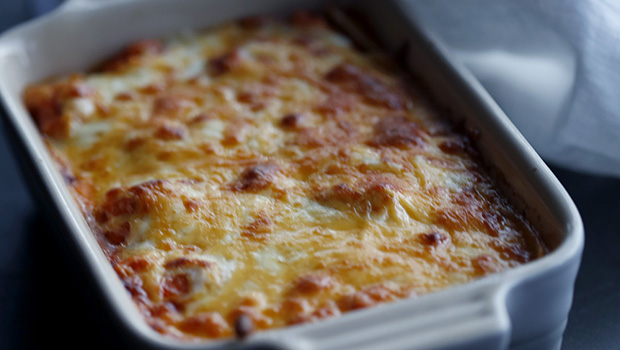What is it about lasagne that makes it such a perfect pasta dish? Is it the combination of the tomato and béchamel, the satisfying cheese-pull when you tuck in or the nostalgia-inducing warmth that hits you when you have a hearty helping of pasta, everyone’s favourite comfort food?
Maybe it’s because the making of it is just as therapeutic and comforting as it is to tuck in. Oh, and there’s scientific evidence as to why you only feel good things when you “treat” yourself – tasty food releases dopamine, the “feel-good” hormone, in our brains.
So from a serial lasagne-maker and dopamine-chaser, here are five tips to help you make the perfect lasagne.
Pasta: To cook or not to cook?
Our advice? Boil your pasta first. Sure, the pasta box will say you don’t need to cook your pasta, but you’ll be surprised at how long it takes to cook through in the oven.
Cook your sheets of pasta in salt water with a bit of olive oil until al dente (they’ll cook a bit further in the oven). Stir them constantly while they’re in the water, so they don’t stick together. Then plunge them into cold water to stop the cooking process.
It’s all in the layers
Your lasagne will consist of layers of pasta: a tomatoey-meat sauce, béchamel (or a ricotta filling) and cheese (we like to use mozzarella, with cheddar over the top). Start with a thin layer of meat or white sauce at the bottom before starting with a layer of pasta (just so it doesn’t stick), then your meat sauce, béchamel, followed by your mozzarella – and repeat several times.
You want to use a deep enough dish to repeat the process at least three to five times.
Another tip we can’t stress enough: don’t make your sauce layers too thick. Lifting your cut squares out of your dish post-bake can be a total sloppy nightmare.
The best advice we can give you for baking: follow the temperature instructions on your pasta package. If you aren’t cooking your pasta sheets before the time, expect a slow bake of around 30–45 minutes at 200°C in your preheated oven. Cook it with a foil covering so as not to dry it out, but remove it 15 minutes before the end of your bake for your cheese to crisp up and brown.
If your pasta’s already cooked, you can bake your dish for half the time without the foil.
Allow your dish to rest
At this point, you’re probably in a hurry to tuck in … don’t! Allow your dish to rest when it comes out of the oven for at least 10 minutes. Your layers will settle and won’t slide about – or turn into that sloppy mess – when you’re dishing.
Always make extra
Lasagne, as therapeutic as it is to make, is a real labour of love. You’re making several sauces, it’s a process to put it together, and it disappears from the table far too quickly. Always make enough for an extra dish – and freeze it.
Instructions from frozen: Cover your dish with foil and bake for roughly 1 hour to 1 hour and 15 minutes at 200°C, removing the foil for your cheese to brown 15 minutes before your bake is complete. If your pasta is cooked before you freeze it, your dish will need less time. But give it long enough for the heat to circulate all the way through to the middle.
Remove it from the oven and allow it to rest, and get ready to treat yourself.
Try some of our favourite lasagne recipes:
Yotam Ottolenghi’s spicy mushroom lasagne

